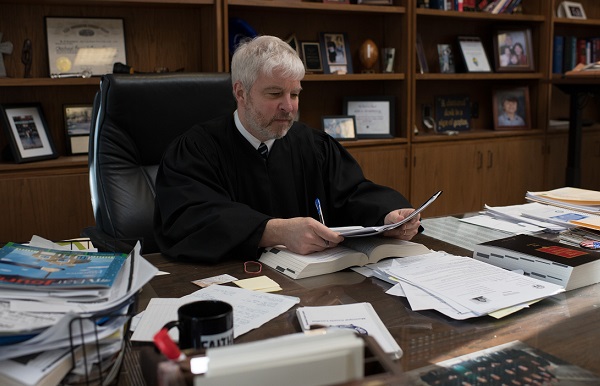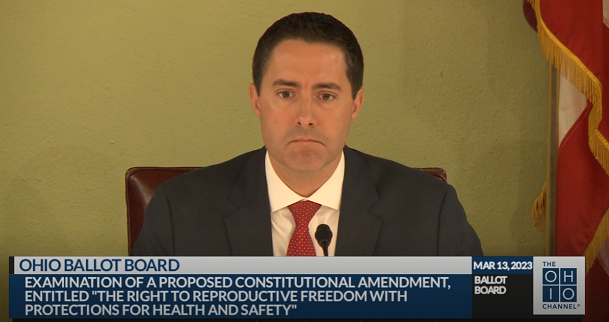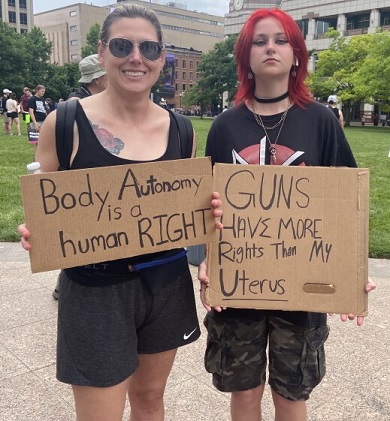Ahead Of Abortion Vote, Ohio Supreme Court Has Ordered A Rewrite Of Some Misleading Ballot Language!
FEATURED PHOTO: OHIO REPUBLICAN SUPREME COURT JUSTICE PAT FISCHER

Associated Press, By Julie Carr-Smythe. Posted September 28th 2023
A wildly divided Ohio Supreme Court ruled late Tuesday that only one element of the disputed ballot language for describing a closely watched fall abortion rights question is misleading and must be rewritten.
The decision lets stand most of the word choices targeted in a lawsuit by Ohioans United for Reproductive Rights, the pro-abortion rights ballot campaign, as well as the substitution of “unborn child” for “fetus,” which it chose not to dispute.
But it also marked the high court’s second slap this year at the Republican-led Ohio Ballot Board’s chosen wording for describing constitutional amendments to voters. In June, justices ordered the panel to reword its description of a divisive August constitutional amendment that would have made amending Ohio’s constitution harder.
In both cases, the summaries were advanced by Republican Secretary of State Frank LaRose, an abortion opponent and 2024 U.S. Senate candidate who chairs the panel in his role as state elections chief.
In last week’s ruling, the court invalidated board language that suggested the amendment would limit “citizens of the State” from passing laws to restrict abortion access, when it actually limits state government from doing so. It ordered the board to reconvene to rewrite that one section, as preparations are already underway for the Nov. 7 election.

Only two of seven justices — Republican Pat Fischer and Democrat Michael Donnelly — were in full agreement on the decision. All five others agreed in part, and disagreed in part.
In a majority opinion written by Fischer, the court rejected an argument made by Republican Attorney General Dave Yost that “citizens of the State” and “the State” are the same, on grounds that Ohio has a government “of the people.”
Fischer noted that the Ohio Constitution never uses the phrase “citizens of the state,” that citizens and the state are “not necessarily synonymous,” and that the approved language, as a result, “would not accurately tell the voters what they are being asked to vote on.”
“Instead of describing a proposed amendment that would establish a right to carry out reproductive decisions free from government intrusion,” he wrote, “the ballot language’s use of the term ‘citizens of the State’ would mislead voters by suggesting that the amendment would limit the rights of individual citizens to oppose abortion.”
The abortion amendment, as phrased, would establish “a fundamental right to reproductive freedom” with what backers describe as “reasonable limits.” The proposal would prohibit government restrictions on abortions and other forms of reproductive care up until the point of fetal viability outside the womb.

After that, state laws could limit abortions, as long as they maintained exceptions for the life or health of the pregnant patient.
Viability falls typically around the 24th week of pregnancy, close to the point where most abortions are illegal in Ohio now. That juncture long stood as the standard under Roe v. Wade, the landmark U.S. Supreme Court case that had guaranteed nationwide abortion access, until it was overturned last year. That decision kicked abortion access decisions back to the states.
Ohioans United for Reproductive Rights, the fall ballot campaign, and Yost’s office engaged in a fierce back-and-forth in court filings over the disputed ballot language.
The abortion rights campaign’s lawsuit challenged five separate pieces of the state’s language, including its reference to the right to “medical treatment” rather than to making and carrying out “one’s own reproductive decisions.”
Last week, justices found that wording was not misleading, but “imprecise at worst.”
The court also upheld challenged sections of the ballot language that: omit references to forms of reproductive care besides abortion that would be protected under the amendment; and suggest physicians alone, as opposed to a professional determination of fetal viability, determine abortion decisions.
In their legal filings, attorneys for both sides traded barbs using imagery drawn from sci-fi and fantasy novels.
The state’s attorneys told the court that when the amendment’s backers objected to the use of “medical treatment” in the language, as a substitute for “reproductive decisions,” they were acting “as if making a decision in one’s own mind is somehow controllable by outside forces. Such a concept has been confined to science fiction and dystopian novels and the mechanism to do so has eluded the most imaginative of authoritarian regimes.”
The abortion rights campaign likened some of the state’s arguments to a scene with Alice from Through the Looking Glass. “When they try to justify the ballot language that emerged from that tainted process, (Ohio’s attorneys) borrow a page from Lewis Carroll: ‘When I use a word,’ Humpty Dumpty said in rather a scornful tone, ‘it means just what I choose it to mean—neither more nor less,’” attorneys for the amendment’s backers wrote








